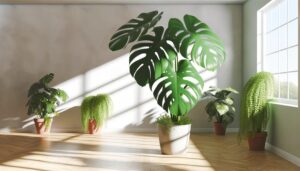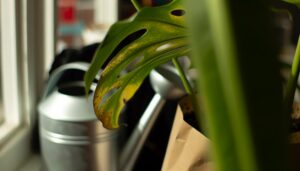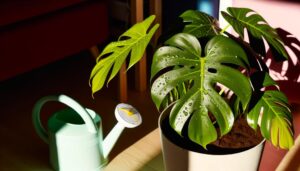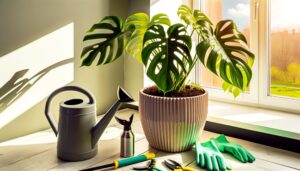What to Plant Monstera in? Best Soil and Pots!
Plant your Monstera in a well-draining soil mix with 30-40% perlite and orchid bark to promote aeration and moisture retention. Use a pot with ample drainage holes, avoiding waterlogging and root rot.
Choose a terracotta or ceramic pot that’s 2-4 inches larger than the root ball for stable growth. Regularly repot every 1-2 years to promote healthy development.
Enhance soil nutrients with worm castings, compost, or aged manure. This setup ensures robust plant health and strength.
Explore further to master thriving Monstera care.
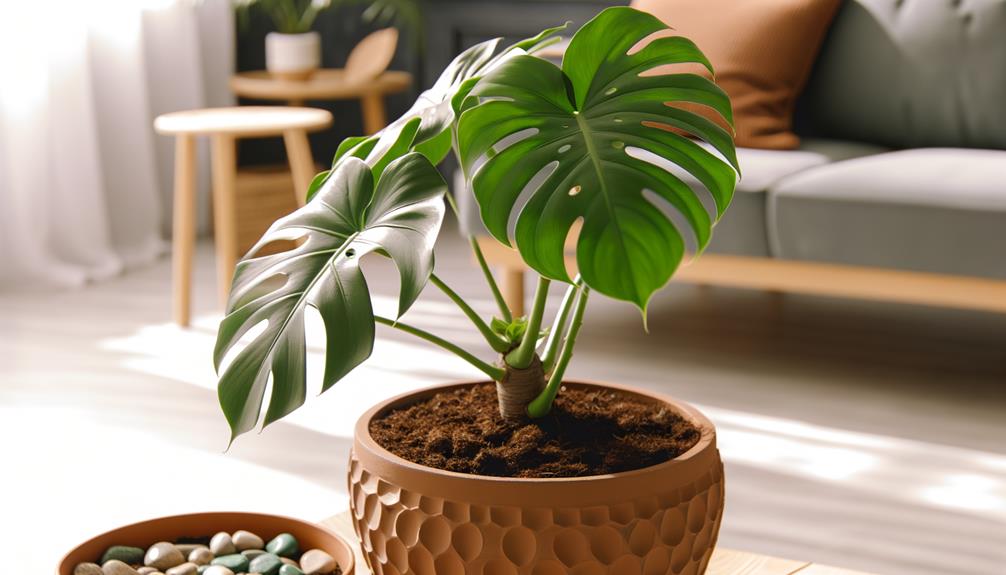
Key Takeaways
- Use a well-draining soil mix with organic matter, perlite, and orchid bark.
- Select a pot with ample drainage holes to prevent root rot.
- Choose terracotta or ceramic pots for stability and aesthetics.
- Ensure the pot size is 2-4 inches larger than the root ball.
- Incorporate organic additives like worm castings or compost for nutrient enhancement.
Ideal Soil Composition
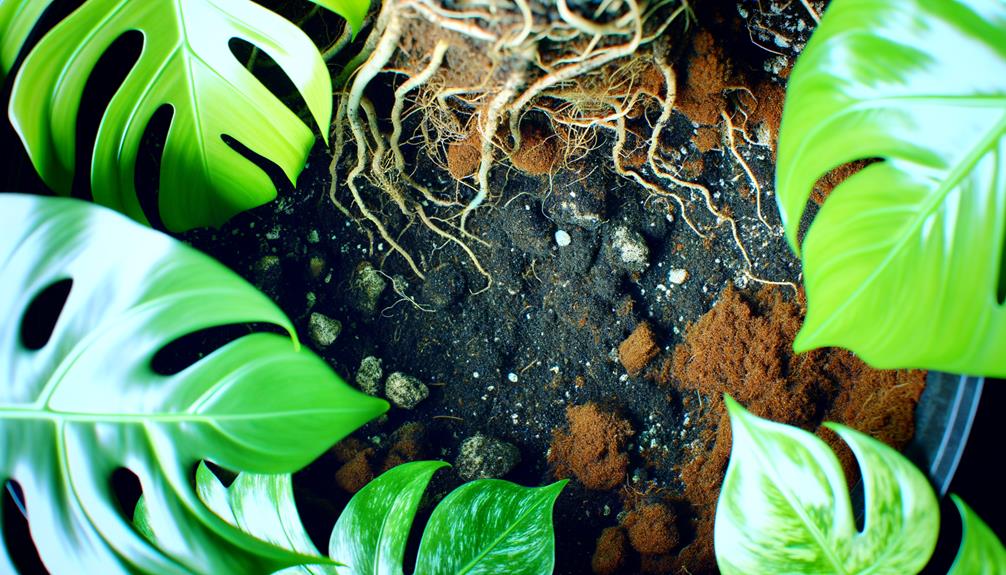
To achieve peak growth for your Monstera, use a well-draining soil mix rich in organic matter and aerating components like perlite or orchid bark.
You’ll want to make sure the soil mimics the plant’s natural habitat, which is the tropical rainforest floor. Start with a base of high-quality potting soil.
Enhance it by adding 30-40% perlite to improve drainage and aeration. Incorporate orchid bark or coconut coir to provide additional organic matter, which helps retain moisture without causing waterlogging.
Choosing the Right Pot
When selecting a pot for your Monstera, prioritize drainage and an appropriate pot size to prevent root rot and support healthy growth.
Opt for materials like terracotta or ceramic that offer stability and match your aesthetic preferences.
Confirm the pot has sufficient drainage holes to facilitate proper water flow and aeration.
Drainage and Pot Size
Selecting the right pot for your Monstera is important, as inadequate drainage can lead to root rot and stunted growth. Opt for a container with drainage holes to make sure excess water escapes, preventing waterlogged roots. Monstera roots require aeration; a well-draining potting mix is also vital.
When choosing pot size, consider your Monstera’s current root ball. A pot that’s 2-4 inches wider in diameter than the root ball allows room for growth without overwhelming the plant. Oversized pots retain moisture longer, increasing root rot risk. Conversely, undersized pots restrict growth.
Repotting every 1-2 years as the plant matures ensures continued healthy development. Remember, proper drainage and appropriate pot size are essential for thriving Monstera plants.
Material and Aesthetics
Selecting the appropriate material for your Monstera’s pot ensures not only best growth conditions but also complements your home’s aesthetic. Your choices largely impact the plant’s health and visual appeal.
Here are three excellent options:
- Terracotta – Porous and breathable, terracotta pots facilitate optimal aeration and moisture regulation, essential for Monstera’s root health.
- Ceramic – Glazed ceramic pots retain moisture effectively and come in various designs, perfect for adding a touch of elegance to your space.
- Plastic – Lightweight and versatile, plastic pots are budget-friendly and retain moisture well, ideal for those who might forget regular watering.
Each material offers specific benefits, so select based on your Monstera’s needs and your interior design vision.
Drainage Essentials
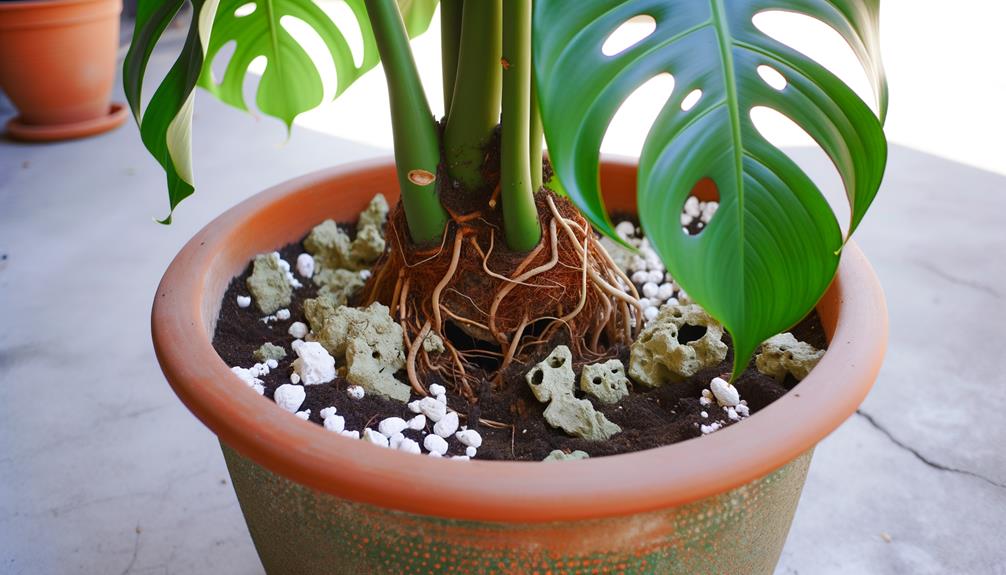
Choose a pot with sufficient drainage holes to prevent root rot.
Utilize a well-aerated soil mix, abundant in organic matter and perlite, to promote proper water flow.
Prevent waterlogging by enabling excess water to escape freely, fostering a healthy root environment.
Avoiding Waterlogging
Proper drainage is crucial to prevent waterlogging, which can lead to root rot and hinder Monstera’s growth. You need to guarantee your pot has adequate drainage holes and use a well-draining soil mix.
Follow these steps:
- Choose a Pot with Drainage Holes: Confirm the container has multiple holes at the bottom to facilitate water outflow.
- Use a Well-Draining Soil Mix: Combine peat moss, perlite, and bark to create a soil mix that retains moisture without becoming waterlogged.
- Add a Layer of Gravel: Place a thin layer of gravel at the pot’s base to improve water drainage and prevent soil compaction.
Pot Size Matters
Selecting the right pot size is crucial for your Monstera’s root development and overall health. Start with a pot that’s 2-4 inches larger in diameter than the root ball. This provides ample space for root expansion without causing excessive moisture retention, which could lead to root rot.
As your Monstera matures, repot every 1-2 years, choosing a pot incrementally larger each time. Make sure the pot has drainage holes to facilitate proper water flow and prevent waterlogging. Avoid overly large pots since they can result in stagnant soil and poor aeration.
Best Potting Mix
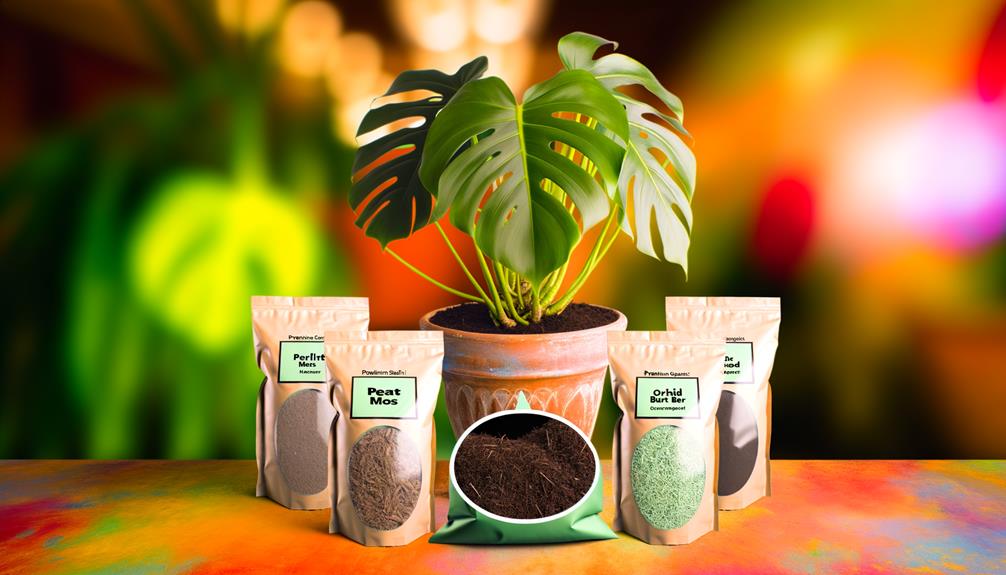
For best growth, use a well-draining potting mix that mimics the Monstera’s natural tropical environment, guaranteeing the blend includes components like peat moss, perlite, and orchid bark. These elements provide essential aeration, moisture retention, and structural support.
Here’s a precise mix you can follow:
- Peat Moss: Facilitates moisture retention and provides an acidic pH, which Monsteras prefer.
- Perlite: Enhances aeration and drainage, preventing root rot and promoting healthy root growth.
- Orchid Bark: Adds structural integrity, simulating the Monstera’s native epiphytic conditions, and preventing soil compaction.
Combine these components in equal parts to create an ideal growing medium. This mix guarantees your Monstera roots receive adequate oxygen and moisture, fostering vigorous growth and lush foliage.
Organic Additives
To enhance the nutrient profile of your Monstera’s potting mix, consider incorporating organic additives like worm castings, compost, or aged manure. These natural amendments not only improve soil structure but also boost microbial activity and nutrient availability.
Worm castings are rich in essential nutrients such as nitrogen, phosphorus, and potassium. Compost provides a balanced nutrient supply and enhances soil aeration, while aged manure contributes organic matter and beneficial microorganisms.
Here’s a quick comparison of organic additives:
| Additive | Benefits |
|---|---|
| Worm Castings | High in essential nutrients, improves soil texture |
| Compost | Balanced nutrients, improves aeration |
| Aged Manure | Adds organic matter, boosts beneficial microorganisms |
| Bone Meal | High in phosphorus, promotes root development |
Incorporate these additives to create a thriving environment for your Monstera.
Repotting Tips

After enriching your Monstera’s soil with organic additives, it’s important to understand the precise steps involved in repotting to promote growth and health.
Follow these detailed instructions for a successful repotting:
- Preparation: Choose a pot 2 inches larger in diameter than the current one. Confirm it has drainage holes to prevent waterlogging, which can lead to root rot.
- Root Examination: Gently remove the Monstera from its pot. Inspect the root system for signs of rot or disease, trimming any unhealthy roots with sterilized scissors.
- Potting: Place a layer of fresh, well-draining soil mix at the bottom of the new pot. Position the Monstera in the center, filling in around the roots with more soil. Press lightly to eradicate air pockets.
These steps will guarantee your Monstera thrives.
Decorative Containers
Choosing the right decorative container not only enhances your Monstera’s aesthetic appeal but also contributes to its overall health by ensuring proper drainage and support. Opt for a pot with drainage holes to prevent waterlogging, which can lead to root rot.
Terracotta pots are ideal because they’re porous, allowing excess moisture to evaporate. If you prefer a more contemporary look, ceramic or fiberglass pots also work well, provided they’ve adequate drainage.
Ensure the container has enough space for the Monstera’s robust root system to expand. Aim for a pot that’s 2 inches larger in diameter than the current one.
Additionally, consider using a saucer or tray to catch excess water, preventing surface damage and maintaining humidity levels around the plant.
Conclusion
To sum up, keep in mind that the correct soil and pot are essential for your Monstera’s health.
Were you aware that a well-draining mix can decrease root rot by up to 50%?
Select a pot with sufficient drainage, and repot every few years to cater to growth.
Incorporate organic material such as compost for nutrient-rich soil.
By adhering to these suggestions, you’ll guarantee your Monstera flourishes, displaying its iconic, luxuriant foliage.
Happy planting!


